A nation grieves
It was in the world news early this week. Last Tuesday at 8:10 in the morning, a 7.2 magnitude earthquake struck the tourist island province of Bohol situated in the central Philippines. The power of such temblor was equivalent to 32 atomic bombs, and it flattened houses, crumbled buildings, destroyed bridges, cracked roads and, as of last count, claimed the lives of over 170 people, mostly buried under piles of rubble. The death toll is expected to mount as more bodies are retrieved from under collapsed structures. I have featured Bohol (and the nearby province of Cebu which was also heavily affected) in many previous posts. Both provinces are popular tourist destinations. Bohol in particular is known for its Chocolate Hills , the rare Tarsier, the green Loboc River, pristine beaches and its centuries old churches. Aside from the lives that were lost, the nation grieves with the destruction of 10 heritage churches, all priceless national treasures, some dating back to the 1500s. I had the opportunity to photograph some of these beautiful churches during my early travels, and below I have paired my pictures of them with the pictures I saw in the news in the aftermath of the quake. For us photographers who enjoy capturing old, historic structures, these are heartbreaking sights:
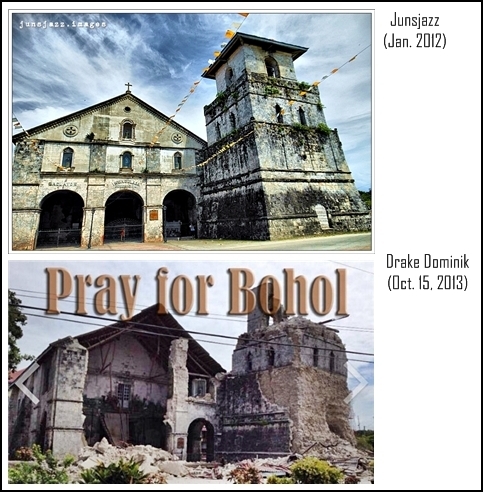 The Church of Our Lady of the Immaculate Conception in Baclayon town, Bohol. Built in 1717.
The Church of Our Lady of the Immaculate Conception in Baclayon town, Bohol. Built in 1717.
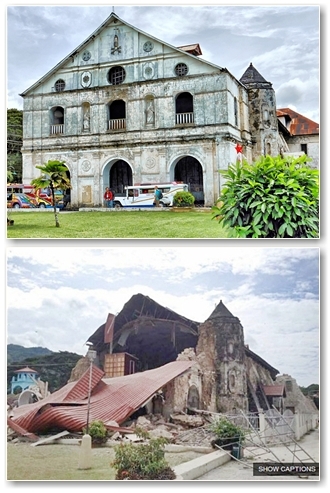 The Church of San Pedro in Loboc, Bohol, originally built in 1602.
The Church of San Pedro in Loboc, Bohol, originally built in 1602.
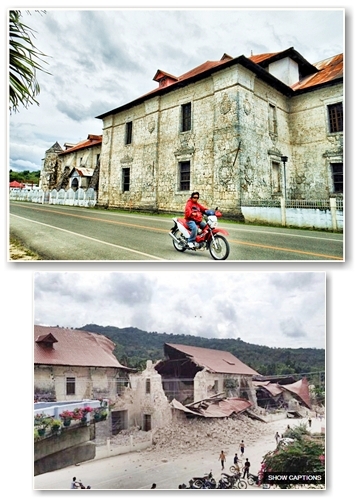
Another picture of the Loboc Church, from the side.
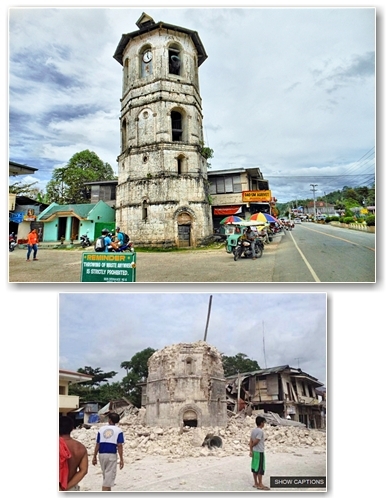 The original bell tower of Loboc Church stands some 100 meters away from the church structure. Now it’s just a stump on the ground.
The original bell tower of Loboc Church stands some 100 meters away from the church structure. Now it’s just a stump on the ground.
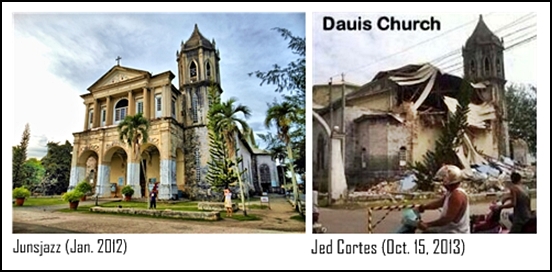 The Church of Our Lady of the Assumption in Dauis, Bohol built by Jesuits in mix style but influenced by Byzantine and Romanesque architecture.
The Church of Our Lady of the Assumption in Dauis, Bohol built by Jesuits in mix style but influenced by Byzantine and Romanesque architecture.
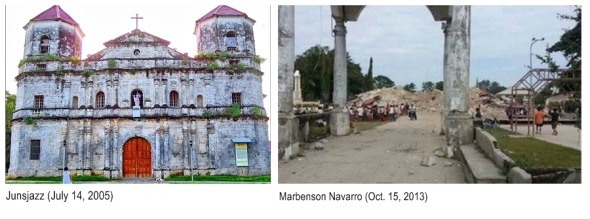 The Church of Our Lady of Light in Loon, Bohol was the biggest church in the province, built in 1753. The whole structure was pulverized to the ground.
The Church of Our Lady of Light in Loon, Bohol was the biggest church in the province, built in 1753. The whole structure was pulverized to the ground.
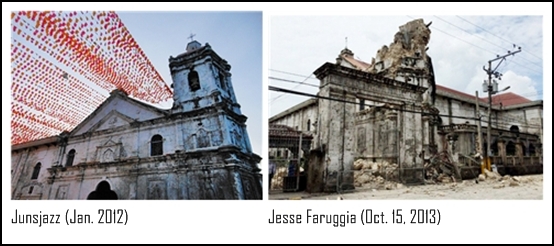 The Minor Basilica of the Holy Child in Cebu City, founded in 1565. It’s belfry fell off.
The Minor Basilica of the Holy Child in Cebu City, founded in 1565. It’s belfry fell off.
These old churches were built with materials during those times – coral stones, mud bricks, limestones – and are most fragile. Throughout their history, they have been subjected to fires, typhoons, previous earthquakes and even World War II. They were the first to come down during the powerful quake this week. Experts are assessing if some of them can be rebuilt, while others like the Loon Church which was flattened, may have a new church built on the site. I am quite fortunate to have captured the beauty and grandeur of these churches in their original condition before the disaster. Now I have them immortalized in images, and preserved in my memory as I saw them in their full glory.
Note: These churches are featured in Junsjazz Images & Inspiration Digital Magazine Issue #2.
Missed you all!
After nearly two months, I missed a lot – this blog and the great WP community of photo blogger peers – that’s all of you my friends! My apologies, I’ve been bogged down by online work. But my deepest thanks to all who commented, liked and visited during my absence. I’ll try my best to go around and visit your blogs during my free time. Keep on clicking everyone!

Belfry
The first thing I notice in a church from the outside is the belfry, or the bell tower. Since they are usually the tallest part of a church structure, they have that prominence in the overall architectural design underscoring their functional importance. There are churches with dual belfries while others have singular towers. Here are samples of belfry images from my collection:
 Baclayon Cathedral, Bohol Province
Baclayon Cathedral, Bohol Province
 Guimbal Church, Iloilo Province
Guimbal Church, Iloilo Province
 Basilica de Sto. Nino, Cebu City
Basilica de Sto. Nino, Cebu City
 Batangas Basilica, Batangas City
Batangas Basilica, Batangas City
 The old Loboc Church Belfry, Bohol Province
The old Loboc Church Belfry, Bohol Province
 Sto. Nino Church, Tacloban City
Sto. Nino Church, Tacloban City
 San Agustin Church, Intramuros, Manila
San Agustin Church, Intramuros, Manila
Interesting interiors
For me, the interiors of churches are as much of a photographic delight as its exteriors. The grandeur in the outside is complemented or even topped off by the elaborate inside. You’ll find ornate pieces, sophisticated ceilings, fancy wrought-iron designs, luxurious stained-glass windows, and hundreds of other items of interest. It’s literally a photographer’s heaven.
 Church of Santo Tomas de Villanueva, Miag-ao town, Iloilo province
Church of Santo Tomas de Villanueva, Miag-ao town, Iloilo province
A treasure trove
The above is the facade of the St. John of Sahagun Parish Church in the historic town of Tigbauan, Iloilo province. Nothing really extraordinary in its Baroque-inspired exteriors, but wait till you get inside. Whoa, don’t scroll down and enter just yet! Before that, let me first share a description from Wikipedia:
Tigbauan, is one of Iloilo’s treasure trove, packed with “gems” from more than a millennium of historical significance. With one foot in the past, and the other in the present, Tigbauan allows every visitor a glimpse of its heady blend of architectural masterpieces and natural wonder, the town’s 134 years of history are on display when you look.
The town delights its St. John of Sahagun Parish. Constructed using forced labor under Fray Florencio Martin in 1867, its beautiful baroque facade in rococo finish, allow visitors a glimpse of the community’s intense spirituality. The church’s remarkable architecture with its façade and tower, survived the ravages of the Second World War and the great earthquake in 1948. Presently, the mystical beauty of its altar depicts heaven and Dante’s Inferno; the church walls with the Way of the cross, all done in intricate mosaic of colored stones is a sight not to be missed. On its churchyard remained a marker of what used to be the site of the first Jesuit boarding school for boys in the Philippines established in 1592 and renowned that time for their liturgical music during church services.
I guess you saw the key words and phrases “mystical beauty of its altar” and the “intricate mosaic of colored stones.” Let’s go inside. Below are a couple of images reflecting those key phrases.
You have to see the place in person to appreciate fully these spectacular works of art. The Wikipedia description doesn’t even come close. According to town folks I talked to, those are not just colored stones but also shells and corals (no environmental restriction on corals during those times) shaped into tiny tiles (thousands of them), painted, pieced and placed together, one by one, by hand. They are all around on the interior walls, columns and the famous half-dome ceiling in the main alter.
Churches are treasure troves of artifacts, relics, antiquity and extraordinary art. All are potential photographic subjects. Discover them and document them well. These are priceless – both of your images of them and the rich history that comes with them.
Symbols of faith redux
I never thought I had so many church articles and images already posted in the past nine months. I’d like to repost the article but pair it with altogether different images. This is titled Symbols of Faith posted last November 27, 2012.
I have around five previous posts regarding pictures of churches and how to photograph them. I can’t get enough of them so here’s another one which is probably not the last since I have a whole collection of them. My country the Philippines has a population of 95 million and 90 percent of them are Catholics. It is the only predominantly Catholic country in Asia, brought about by 300 years of Spanish colonial rule which started in the 1500s. The influence of religion is thus ingrained and pervasive in the peoples’ psych and culture, and most evident in the places of worship. From the far-flung towns to the urban centers, church structures abound, from the modern to the centuries old. They stand as symbols of faith, much like the Muslim mosques and the Buddhist temples. To individuals like me, churches, basilicas and cathedrals are profound photographic subjects. They have this visual grandeur and alluring solemnity. They invoke an aura of mysticism, serenity and of course spirituality. Those are intangibles that are represented in what we can see – the shapes, form, patterns, details, lines – elements which are in the microcosm of the physical church structure whether in its cavernous interior or its towering exterior. When you get the chance to tour my country, make it a point to visit the churches. First give thanks to the Almighty for all the blessings he has given you in this life, then pray that all the pictures you’ll take afterwards will be sharp, vivid, clear and in focus. Amen.
(Picture on top is the Miag-ao Church in Iloilo province – one of four Baroque churches in the Philippines listed in the UNESCO World Heritage Sites, while below is the Pan-ay Cathedral in the province of Capiz)
Church week
This excerpt was taken from my post last Oct. 14, 2012 titled Solemn Sanctuaries:
I always have this fascination for church structures, the older and bigger, the more interesting. They are such imposing landmarks with their towering belfries, ornate decors and massive interiors, fulfilling their roles as venerable venues for the faithful, and solemn sanctuaries for the Lord’s flock. The Philippines is a showcase of ancient churches, cathedrals and basilicas. As the only predominantly Catholic country in Asia, churches big and small, old and new abound all over the Philippines.
Yes folks, we revisit the churches, cathedrals and basilicas in my image collection, and how it is to capture the grandeur and details of these architectural landmarks. Welcome to another of JJ’s picture series. Have a splendid week ahead my friends!
Port call
Piers and ports are not the most picturesque of subjects and locations. These places are usually a tangle of cargo, industrial materials and whatever can be transported on large ships. Then there are people. Unlike airports which are built as symbols of architectural beauty, ports are just that – transport hubs that play important roles in a country’s trade and commerce. We photographers, however, don’t always go for the picturesque, we go for the “photographable” whether it is a thing of beauty or not. There will always be a photo-reporter in us, capturing the essence and mood of a place. We like to document reality – the “how it is” as oppose to “how it should be” – simply because there are times we do not have a choice on our subject and situation. In other words, what we see is what we get. A wise photographer will visualize and compose his shot then seize the scene, be it a visually inspiring airport or a description-defying port.
Expressions
This to me is the joy of informal people photography – being able to capture pure, spontaneous, unrehearsed, off-the-cuff moments of genuine expressions, such as in this series of images taken at a local water festival.
Enjoying the cinematic feel
I have been playing with this 16:9 aspect ratio and I’m loving it. Based on what I’ve picked up on my online readings and personal experiences, I found that this aspect ratio provides the following:
- A cinematic feel
- A whole expanse of placing your subjects
- A great way of having a negative space
- A different way of “macroing” focusing only on certain parts of the subject
- A splendid landscape view
Recently I have shifted to using 1:1 square format in my black and white images, now I’ll be using regularly the 16:9 and utilize its full potentials in my color photography. There is so much to learn and I’m enjoying it in this photographic journey of discovery and expression.
Go out and shoot
Article Excerpt:
Go Out & Start Shooting
The human brain wants you to find the perfect idea. By going out and shooting whatever random subject matter is there (no matter how dull) can create inspiration within itself. Go out and shoot that fire hydrant, doors, trees and whatever other random, dull, static objects you may find in your line of vision! It may lead you somewhere unexpected.
Find A Color
Go out and shoot one color. Narrowing your subject matter down to one color will make you see photographs you never would have otherwise. Different colors have different moods too. If you are feeling calm and cool, go shoot blue. Do you feel happy? Shoot yellow or orange. There are many internet resources that you can look into to explore the color wheel and emotional interpretation of color.
~Some Thoughts on Photography by Dr. Dennis Woytek
The urban feel
Article Excerpt
Towns and cities often have their own unique “feel” that makes them different from anywhere else. A successful urban landscape photo should capture this essence, but it isn’t always an easy task. The key is to think about what the place means to you, how it makes you feel, and what places are special to you. Then look around for a way to introduce this feeling into your photo.
Small details can really add atmosphere to an urban landscape photo, so try to include them alongside the more obvious subjects such as impressive buildings or monuments. Things like an overflowing rubbish bin, a cracked pavement tile, or a traffic jam tell a story in themselves, and help to give your urban landscape shots context.
Don’t forget that the vibe of a city doesn’t always need to be a positive one – sometimes you might want to show just how dirty and unfriendly a place is. Your photos should always tell a story from your point of view – after all, urban landscape photography is just as much about self-expression as it is about showing off a town or city.
~Urban Landscape Photography Tips from PhotographyMad.com
Photo Quotes 143
Composition does not just happen; there must be a need for expression, and substance cannot be divorced from form. – Henri Cartier-Bresson
Calculated luck
Article Excerpt:
Candid Photography as an Art Form, is I’ll admit part luck but its calculated luck. You put yourself in a place or position that gives you the greatest chance of capturing a subject that suits your eye, or at least comes close to what you’re looking for. If you find something of interest you can’t pose it you have to take it as it is or have the patience of a saint to wait it out until it gives you an opportunity for a reasonable shot. If it’s the type of subject that is movable then you have fractions of a second to compose the shot set the focus and shoot it. If you have the wrong lens at the time or the lighting isn’t the best you don’t have time to change it, you do the best you can with what you have. You can’t control the lighting unless you spend the time to determine when is the best time to get the shot you want with the best lighting. It’s the most frustrating art media I have ever dealt with. To come up with a truly candid artistic photograph you might be lucky if you get the opportunity to come up with one acceptable shot out of hundreds…It is my opinion that a good photographic artist has to have the eyes of an eagle to be able to focus and see its subject at the best angle in order to capture it, the speed of a mongoose avoiding the bite of a cobra, the patience of a saint and the dexterity to utilize their equipment available to them at the moment instantly and correctly.
~Paul Viverito from his article Candid Photography as an Art Form
Capturing life moments
Candid photography is about capturing life moments as they happen. This is where the photographer is unnoticed by the subject, hence there is no posing or awkwardness. It’s the real deal, a slice of life that is documented. Candid shots are best for sports action, group activities and street photography.
I’m sharing an article by Sarah Harbuck titled Photography Tips: How to Take Better Candid Photos. In it she presents the following:
1. Become inseparable with your camera.
2. Take lots of photos.
3. Turn your flash off.
4. Use a zoom lens.
5. Get in the right position.
6. Use your creativity.
7. Be in the moment.
8. Observation is key.
9. Melt into the background.
10. Don’t try too hard.
If you can spare a minute, head over to the article and read it in full. Candid images are fun, spontaneous and unreserved. They are images we can relate with, all too human and all too normal – a tick of time and a second of daily life recorded for posterity. The above photo was taken at Sentosa Resort in Singapore where a lone guy enjoys a good read by the beach. Happy candid snapping!
Capturing the realism
The picture below was taken at Baluarte, a seaside park in the tourist island province of Bohol in central Philippines. When I reviewed the picture in my computer, it was far from what I saw on that day. My picture was bland and boring. It had to undergo post-processing to highlight the colors and details to more or less approximate the actual scene. How do we go about capturing the realism of a scene when we first saw it?
Kimball Larsen shares some pointers in his article 10 Photography Tips To Better Capture What You See. They are the following:
1. Decide on a clear center of attention
2. Remember that your eye has a better dynamic range than your camera
3. Aperture control for DOF
4. Careful composition to either expand upon or contract the feel of the photo
5. Be ready – moments come and go quickly
6. Understand the exposure triangle
7. P is not for “Professional”
8. Pay attention to your light sources
9. Always check your camera settings
10. Practice!
Again I suggest you go over the article and read Larsen’s descriptions on each tip. Giving thoughtful consideration to the above items will greatly improve our picture-taking. It helps elevate us to the level of a thinking photographer, deliberate and confident that our every shot will result in a faithful capture of what we saw. Happy shooting this weekend!
Time exposure
Here are very interesting photography tips all relating to time exposure. This is just a partial list, head over to the online site to view the articles and photo samples.
Photo Tip: Every photograph is actually a time exposure. Images may be recorded in a fraction of a second or over hours of time. Yet many people never realize that they can use time as a creative tool in photography. Remember that the shutter speed can be adjusted to do either very long or instantaneous exposures.
Photo Tip: The method of choosing a long shutter speed and following the action as it takes place is called “panning.” Part of the fun of panning is that the photographer is never really certain how the resulting image will turn out. Photographing in this way can sometimes reveal things that our eyes cannot see.
Photo Tip: By understanding how the shutter speed and the aperture settings of a camera work together in any exposure, the photographer can make deliberate choices about what he or she would like to capture. Automatic settings are great for many things, but a basic knowledge of how the camera works will lead to far more creative photography.
Photo Tip: It doesn’t take a long exposure time to blur rushing water. Sometimes the camera can be handheld while achieving this effect. But take a tripod along so that you can try exposures of various length and see which results you like best.
Photo Tip: Although we are tempted to use a very fast shutter speed when photographing wildlife behavior, slowing things down may lead to a more compelling image. The goal is not always a perfectly sharp image.
Photo Tip: Remember, the photographer can move too! You can twirl or run or pan with your camera to create new views. And by varying your shutter speed as you move, a whole series of surprise images can be created.
~National Geographic photography tips feature Simply Beautiful Photos: Time
The essential ingredient in sunset shots
Article Excerpt:
Ok, but there’s more to picking the right spot than just the location. As important as location is, your sunset will almost always be lacking the one essential ingredient that will make it special – a dominant point of interest. And just what might that be? It’s that extra element that gives your sunset an anchor, a sense of scale, a point which will draw the viewer inevitably into the picture.
A photograph of a sunset by itself just doesn’t work. After all, one setting sun is much like any other. Even if you manage to capture the gorgeous color, without a dominant point of interest the image will still end up looking rather boring. Now, having said that I should tell you that, without some forward planning, a dominant point of interest is not an easy thing to include. It might be the silhouette of a sailboat on a glittering, backlit ocean, a barn, a horse, a cow, a tractor, or even a lone tree in the foreground. It could be the silhouette of two lovers walking hand-in-hand down a country lane, a little girl with a small dog on a leash – I’ve used both of those – and I’m sure you can come up with many more ideas of your own.
~Blair Howard fron his article How To Photograph Sunsets
Photo Quotes 137
It’s not when you press the shutter, but why you press the shutter.~Mary Ellen Mark
Show your world
Article Excerpt:
The advent of digital photography and today’s prevalence of affordable digital SLR cameras ensures more people have the capability to capture an inspiring photo. The only question is how to gain the creative skills, aptitude and dedication to make it happen. First we need to understand the basics of what makes a great travel or adventure photo.
East Africa-based adventure writer and photographer Nathan Ward reveals travel photography is about finding the image within its natural setting. “Find big scenery and local colour. Ideally something without a westerner in it! The world isn’t about a photo of some blonde person in their new Patagonia gear standing next to Tsaatan reindeer herders. The story is about the reindeer herders. Show the world and all its magic,” he says.
Finding the image within its natural setting is individual and we all differ in our visual perspective, however when it comes to releasing the shutter, the basic ingredients to attention-grabbing pictures has remained the same since the inception of photography; thoughtful composition, creative lighting and an interesting subject.
~Mark Watson from his article Sharp Shooters: Photography Tips
The location
Article Excerpt:
Here are a few places to consider when heading out to start your photography adventure.
Water: It doesn’t matter where you live or where you go, you are sure to find lakes, rivers and streams with beautiful landscapes surrounding them. On the coasts, you can get amazing shots of oceans as well. When looking at these locations, determine what makes them unique. Is it a fast moving river or a lazy, slow stream? Figure this out and then decide if you want it to be the focal point of your composition or just a device to use to focus on something beside or in it. You can also find amazing reflections in the water, which will enhance your photographs even more.
Forests: Forests present a photographer with numerous opportunities. Look around and decide if the forest is open and welcome or enclosed and gloomy. When you find the “personality” of the forest, decide what objects in the forest will allow that attitude to come to life in your photographs. It can be a tree, a winding path or a colorful break in the greenery. Find what makes the forest come to life and capture it in your photographs.
Plains: The wide open spaces, especially in the Midwest, can seem dreary and boring but, with the right eye, this can also become the scenic photographers dream. The most important thing to find here is something to focus on. Find an old road sign, a barbed wire fence or an old gravel road and then use these items to show the vastness of the open space beyond it. The plains are also a great place to get amazing shots of the sky as it morphs and changes colors throughout the year.
Mountains: Remember, you are not just shooting mountains, you are shooting something with the mountains in the background. Sure, there can be some amazing pictures displaying the curves of the mountains but those photographs can get boring after awhile. Instead, find something close to the camera, such as a tree or a person admiring the mountain. Using this subject, the mountains will look vast and immense in comparison.
~Shawn Lealos from his article Scenic Photography: Getting the Most out of Your Outdoor Shoot
Create a pleasant mood
There’s something about a serene, romantic setting. It sets you in the mood. It puts you at ease. It is a feeling of rest and relaxation, of slowing down from a hectic, fast-paced life. Al you want to do in a scene such as the picture below, is to get a table, order the best meal for you and your date, and enjoy the quiet, relaxing seaside view.
We have known that images can create mood and character. Now mood is triggered by how we feel about a particular image. If your intention is to shock and startle, then you take shocking pictures. Which is not my forte. I go for the pleasant, feel good and inspiring images. It is beautiful, appealing and interesting images that reach out and relate to majority of viewers. This is the mood that is produced with subtle combinations of subject, composition, setting and lighting. They should all work out to make the viewer comfortable, calm, homey and breezy. In a day, people have had enough of unpleasantness and burdens in their work and daily dealings with life. Don’t add to their heavy heart with pictures that create emotional overload. You do great service with images that lighten feelings and energize the soul. You can be powerful in your art, but always be considerate in how you present your image and its message.
Photo Quotes 136
When I use the camera, I often feel like I know part of the people or places I come in contact with.~Christophe Agou





















































